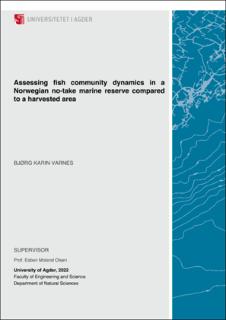| dc.description.abstract | An ecosystem's ability to respond and maintain key functions during environmental change are largely determined by its biodiversity. As human activities continue to alter the composition of biological communities at all scales there is a need for up-to-date status of biodiversity, including how marine fisheries may affect diversity in coastal systems. In this study, I assessed the effect of protection from fishing on a coastal fish community in the Tvedestrand fjord on the Norwegian Skagerrak coast. I compared fish species richness, diversity, composition, catch per unit effort (CPUE), and fish size (body length) between a marine protected area (MPA) and a nearby fished area (i.e., the control). Sampling was conducted by beach seine at eight fixed stations, three in the MPA area and five in the control area, every year from 2011-2021. The MPA was established in 2012 and our sampling therefore included data from before protection (i.e., a before-after-control-impact (BACI) design). In total, more than 26 thousand fish representing 31 species was collected and measured for length. No effect of protection was detected on either species richness, diversity or evenness. Significant differences in species composition were, however, detected between the two areas after protection. In particular, goldsinny wrasse (Ctenolabrus rupestris) accounted for this variation (2012-2015: 27 %, 2016-2021: 14 %). All species combined, CPUE was significantly higher after protection, but this increase was seen in both the control area and the protected area, and therefore cannot be linked to protection. Species combined, mean fish length inside the MPA was significantly higher than in the control area, but this difference was also seen in the data collected before protection. The samples of cod (Gadus morhua), as well as three-spined stickleback (Gasterosteus aculeatur), black goby (Gobius niger) and goldsinny wrasse were analysed in further detail. There was a tendency for an increase in CPUE of black goby, cod and goldsinny wrasse after protection, but this increase could not be linked to protection as it was also seen in the control area. Body length of cod was significantly higher in the MPA area compared to the control area, but the analyses did not detect any change in this relationship in response to protection. For goldsinny wrasse, black goby and three-spined stickleback there was a greater tendency for a decline in mean body size towards the late period in the MPA area compared to the control area. The latter points toward a response to full protection, potentially involving biological control mechanisms and trophic interactions. Taken together, however, the major findings in this study suggest that MPAs may not necessarily have clear and predictable effects on diversity in the short- to mid-term. Even longer-term monitoring involving more refined data collection and diversity measures could be necessary to reveal community-level consequences of protection. | |
